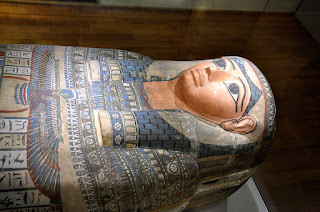domingo, 27 de septiembre de 2020
cat
Head of a block statue
miércoles, 23 de septiembre de 2020
Four Bracelets from the Tomb of King Djer
domingo, 20 de septiembre de 2020
Naos with Statue of a Woman
Ostracon of a Monkey.
erotic figurine
Arsinoe
viernes, 18 de septiembre de 2020
Nakhti, ruler of Asiut
Nakhti, ruler of Asiut
The statuette of the chancellor Nakhti
was found at the beginning of the 20th century in the course of
excavations in the necropolis of the rulers of Asiut. It is a very
original piece: the use of alabaster, which gives a soapy and unfinished
appearance, is exceptional. Nakhti is seated on a cube-shaped seat, and
rests his left hand on his left knee, while his right fist is clenched
on his right knee. The hands and feet are very large in relation to the
rest of his body, and the use of black paint for the eyes and eyebrows
gives the face a very expressive appearance. Even if the statuette does
give the impression of imperfection of form, it does express the
imperturbable strength of a provincial noble living at the beginning of
the Middle Kingdom.
Present location KMKG - MRAH [07/003] BRUSSELS
Inventory number E.5596
Dating MIDDLE KINGDOM
Archaeological Site ASIUT
Category FIGURINE/STATUETTE
Material CALCITE/ALABASTER
Technique HEWN; POLISHED; PAINTED; SCULPTURED
Height 29 cm
Width 12 cm
Depth 21 cm
Bibliography•R. Tefnin, Sculptuur van het Oude Egypte - Statues et statuettes de l'Ancienne Égypte, Bruxelles 1988, 24-27
•J.-Ch.
Balty, e.a., Koninklijke Musea voor Kunst en Geschiedenis, Brussel,
Oudheid - Musées Royaux d'Art et d'Histoire, Bruxelles, Antiquité - The
Royal Museums of Art and History, Brussels, Antiquity, Bruxelles 1988,
18
•F. Lefebvre et B. Van Rinsveld, L'Égypte. Des Pharaons aux Coptes, Bruxelles 1990, 49-50
•E. Teeter, How Many Statues of Nakhti ?, GM 114 (1990) 101-106
•Th. De Putter et Chr. Karlshausen, Les pierres, Bruxelles 1992, 45
•W.
Seipel, Gott, Mensch, Pharao. Viertausend Jahre Menschenbild in der
Skulptur des Alten Ägypten (Exposition), Vienne 1992, 178
•D. Wildung (Éd.), Ägypten, 2000 v. Chr. Die Geburt des Individuums, Munich 2000, 68 et 179 nº 13
globalegyptianmuseum
Group statue of Pepi and Ra-shepses
Statue of the God Thoth with the Godess Maat Squatting in Front of Him
Statue of the God Thoth with the Godess Maat Squatting in Front of Him
This statue represents the God Thoth in the form of an ibis, a bird with long legs, a long curved bill and red eyes.
Maat, who was the goddess of justice and who had been associated with him since the time of the Middle Kingdom, is shown squatting in front of him on a high chair. The goddess wears a long, tripartite wig and rests her arm on her thigh. A hole was cut on her head in which to place the ostrich feather that was her symbol.
Two small figures on two special thin bases flank Maat's chair.
Present location BIBLIOTHECA ALEXANDRINA ANTIQUETIES MUSEUM [01/027] ALEXANDRIA BAAM
Inventory number 622
Dating LATE PERIOD
Archaeological Site TUNA EL-GABAL
Category STATUE
Material WOOD; BRONZE; CALCITE/ALABASTER
Technique HEWN; POLISHED
Height 16 cm
http://www.globalegyptianmuseum.org/detail.aspx?id=14565
martes, 15 de septiembre de 2020
sistrum
sábado, 12 de septiembre de 2020
sycamore coffin contains a mummified body of an Egyptian woman
sycamore coffin contains a mummified body of an Egyptian woman. The hieroglyphic inscriptions on the coffin state that the deceased woman's name is Shepnehor (or Shep-en-hor) and died around 600 BCE. From the necropolis of the Western Thebes, Southern Egypt. The Hunterian Museum at the University of Glasgow, Scotland, UK.
Fragment of a bas-relief from the temple of Cleopatra VII and Caesarion
jueves, 10 de septiembre de 2020
Canopic jar lid with the head of Amset.
Canopic jar lid with the head of Amset. The wig is painted in red, the face in yellow and the eyes in black. 3RD INTERMEDIATE PERIOD Inventory number 15747 MUSEO ARQUEOLÓGICO NACIONAL source: globalegyptianmuseum. org Corresponde a la colección de D. Eduardo Toda y Güell, cónsul de España en El Cairo, comprada por el M.A.N. el 15 de Enero de 1887. Departamento de Antigüedades Egipcias y de Próximo Oriente; PEREZ-DIE, MªC; PONS MELLADO, E.
Shabti for Semity
Necklace
EL IMPERIO EGIPCIO: INSCRIPCIONES, CA 1550-1300 A.C.
miércoles, 9 de septiembre de 2020
Giza plateau mapping project
rekkyt
ave rejit




































